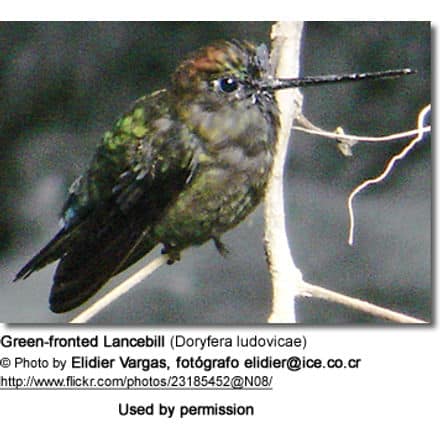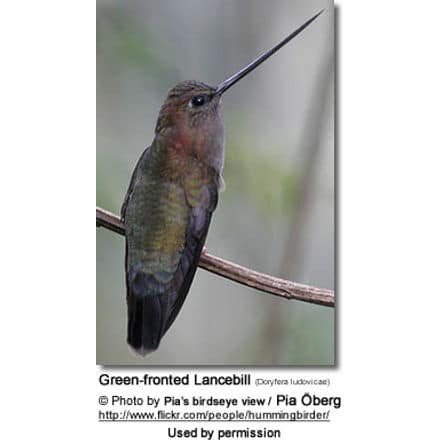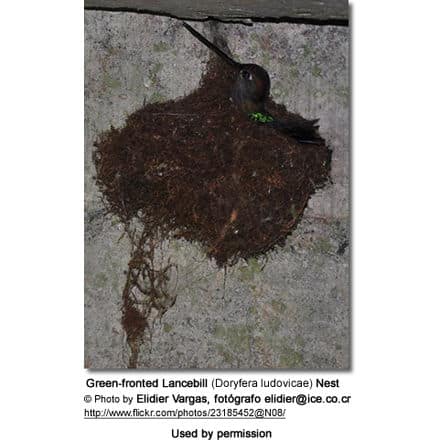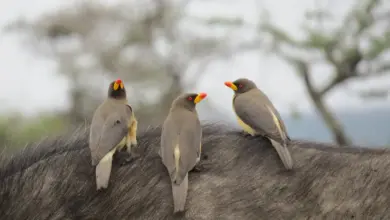Green-fronted Lancebills
The Green-fronted Lancebills (Doryfera ludovicae) is a hummingbird that occurs naturally in the South and Central American countries of Costa Rica, Panama, Colombia, Venezuela, Ecuador, Peru, Bolivia, and Brazil.
They are fairly common in humid and wet forest ravines and along forest borders at elevations of 4,600 – 8,900 feet (1,400 – 2,700 m) or 2,950 – 6,900 feet on the Pacific slope.
The related Blue-fronted Lancebill occurs at lower elevations from 1,300 – 5,200 ft (400 – 1600 m).
Subspecies and Distribution:
-
- Doryfera ludovicae ludovicae (Bourcier and Mulsant, 1847) – Nominate Race
- Found in extreme eastern Panama (Cerro Tacarcuna), Colombia, and western Venezuela south through the Andes to northwestern Bolivia (eastern slope only from central Ecuador southwards).
- Doryfera ludovicae veraguensis (Salvin, 1867)
- Found in north-central Costa Rica to western Panama
- Doryfera ludovicae ludovicae (Bourcier and Mulsant, 1847) – Nominate Race


Alternate (Global) Names
Spanish: Colibrí Picolanza Mayor, Pico de lanza frentiverde, Pico de Lanza Mayor, Pico-de-lanza Frentiverde … Italian: Beccodilancia fronteverde, Lanciere fronteverde … French: Porte-lance de Louise … German: Grünstirn-Lanzettschnabel … Czech: Kolibrík zelenocelý, kolib?ík zeleno?elý … Danish: Grøn Lansenæb … Finnish: Vuoripistinkolibri … Japanese: midoribitaiyarihachidori … Dutch: Groenvoorhoofdlancetkolibrie, Groenvoorhoofd-lancetkolibrie … Norwegian: Grønnpannelansenebb … Russian: ???????????? ??????????? … Slovak: jagavicka zelenocelá … Swedish: Grönbröstad lansnäbb
Description
The Green-fronted Lancebills are about 4″ (10.2 cm) long, including the 1.4″ or 36 mm slender and straight bill.
The upper plumage is metallic green, more greyish-green below. The upper tail feathers are bluish. The tail is steely blue-black tipped grey.
The head of both the male and female often look dull and brownish – particularly in low light conditions.
The female’s plumage is dull, except for the glittering green frontlet. The rest of her crown is bronzy-colored.
Similar species: They resemble the related Blue-fronted Lancebill, but are generally larger. The males are much darker with a violet frontlet compared to the green frontlet of the Green-fronted Lancebill. The females can be distinguished from the female Blue-fronted Lancebill by their larger size, shorter bill, and dull (no coppery) rear crown. The Green-fronted Lancebill occurs at higher elevations than the Blue-fronted Lancebill.
Hummingbird Resources
- Hummingbird Information
- Hummingbird Amazing Facts
- Attracting Hummingbirds to Your Garden
- Hummingbird Species
- Feeding Hummingbirds

Nesting / Breeding
The Green-fronted Lancebills have been observed breeding in July through October with a second brood in December through January.
Hummingbirds are solitary in all aspects of life other than breeding, and the male’s only involvement in the reproductive process is the actual mating with the female. They neither live nor migrate in flocks, and there is no pair bond for this species. Males court females by flying in a U-shaped pattern in front of them. He will separate from the female immediately after copulation. One male may mate with several females. In all likelihood, the female will also mate with several males. The males do not participate in choosing the nest location, building the nest, or raising the chicks.
The female Green-fronted Lancebill is responsible for building the cup nest made from fiber and rootlets 5 – 66 ft (1.5 – 20 m) up on a rocky cave ledge. She lines the nest with moss, soft plant fibers, animal hair, and feathers down, and strengthens the structure with spider webbing and other sticky material, giving it an elastic quality to allow it to stretch to double its size as the chicks grow and need more room.
The average clutch consists of one to two white eggs, which she incubates alone, while the male defends his territory and the flowers he feeds on. The young are born blind, immobile, and without any down.
The female alone protects and feeds the chicks with regurgitated food (mostly partially digested insects since nectar is an insufficient source of protein for the growing chicks). The female pushes the food down the chicks’ throats with her long bill directly into their stomachs.
As is the case with other hummingbird species, the chicks are brooded only the first week or two and left alone even on cooler nights after about 12 days – probably due to the small nest size. The chicks leave the nest when they are about 20 days old.

Diet / Feeding
The Green-fronted Lancebills primarily feed on nectar taken from a variety of brightly colored, scented small flowers of trees, herbs, shrubs, and epiphytes. They favor flowers with the highest sugar content (often red-colored and tubular-shaped) and seek out, and aggressively protect, those areas containing flowers with high-energy nectar.



